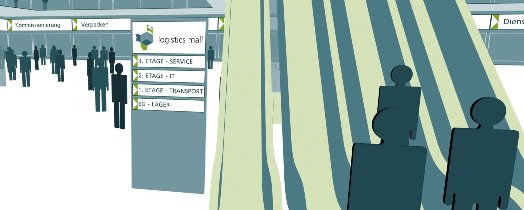Key Project 3 - Logistics Mall
The planned research and development work cumulated in the "Logistics Mall" as a central marketplace for everything from individual logistics IT functionality up to complete process chains, which can be offered as a product. This makes it possible for a company to put together the logistics services they need when they need them and operate them in the Logistics Mall. The opportunity to swap out an individual logistics IT service with the service offered by an alternative vendor at runtime does not only result in new business models but it also avoids dependencies on a service provider.
The internet is both a technological platform and a signpost of the Logistics Mall. The Logistics Mall uses Web 2.0 technology and was developed for the logistics of the future. With Web services as the basis, information and services within the Logistics Mall cannot only be requested but also new high value logistics process can be orchestrated. Like in an online store, the (virtual) user clicks on the desired services and thereby uses a global, open software architecture.
The Mall Marketplace (MMP) is the central marketplace of the Logistics Mall. Logistics service providers and IT vendors can offer their services over the MMP and thereby reach a wider group of users. In addition to this, service providers (called 4PL) can combine IT services into complex logistics processes and offer them as services to cover the individual needs of their customers in the Logistics Mall. The user is also able to create a combination of the services they require as long as they have the required technical expertise. It is through the Mall Marketplace that users of the Logistics Mall gain access to custom tools, such as Logistics Service Designer and Semantic Designer, as well as tools for billing, registering, and deploying the services in the Logistics Mall.
The combination of the logistics and IT services into complex logistics processes requires that the Logistics Mall platform has a suitable infrastructure as well as suitable platform-bound orchestration tools. These tools have to use the semantics-based ontology to identify the necessary services and place them in the right sequence. They also have to fulfil the functions, such as the conditions for calling the individual services as well as defining dependencies and alternatives, and implement the structured repository of the orchestrated logistics processes on the Logistics Mall. The resulting requirements, such as transaction security or the dynamic coupling of IT services to runtime (orchestration of logistics processes), are met through the use of an orchestration engine. This engine has monitoring and control mechanisms that are able to instantiate and execute the individual processes whereby the predefined workflow for the planned business processes is adhered to and implemented.
After the customer determines the Service Levels and purchases services and/or business processes in the MMP, they are made available for their use via a personalized portal, the so-called Customized Access Framework (CAF). The CAF is the central access point for the customer, which includes a personalized user interface for the customer and an execution platform for the products they purchased in the MMP.
The goal of the key project "Logistics Mall" was to develop a platform that would make it possible for the user to design and run vendor-independent logistics services using an innovative modelling methodology. The time required to implement logistics services would be drastically reduced as a result. The guiding principle of the Logistics Mall is an open and federalist service platform that gives rise to a steadily growing ecosystem of encapsulated logistics solutions of different complexities.
 Fraunhofer-Institute for Material Flow and Logistics IML
Fraunhofer-Institute for Material Flow and Logistics IML